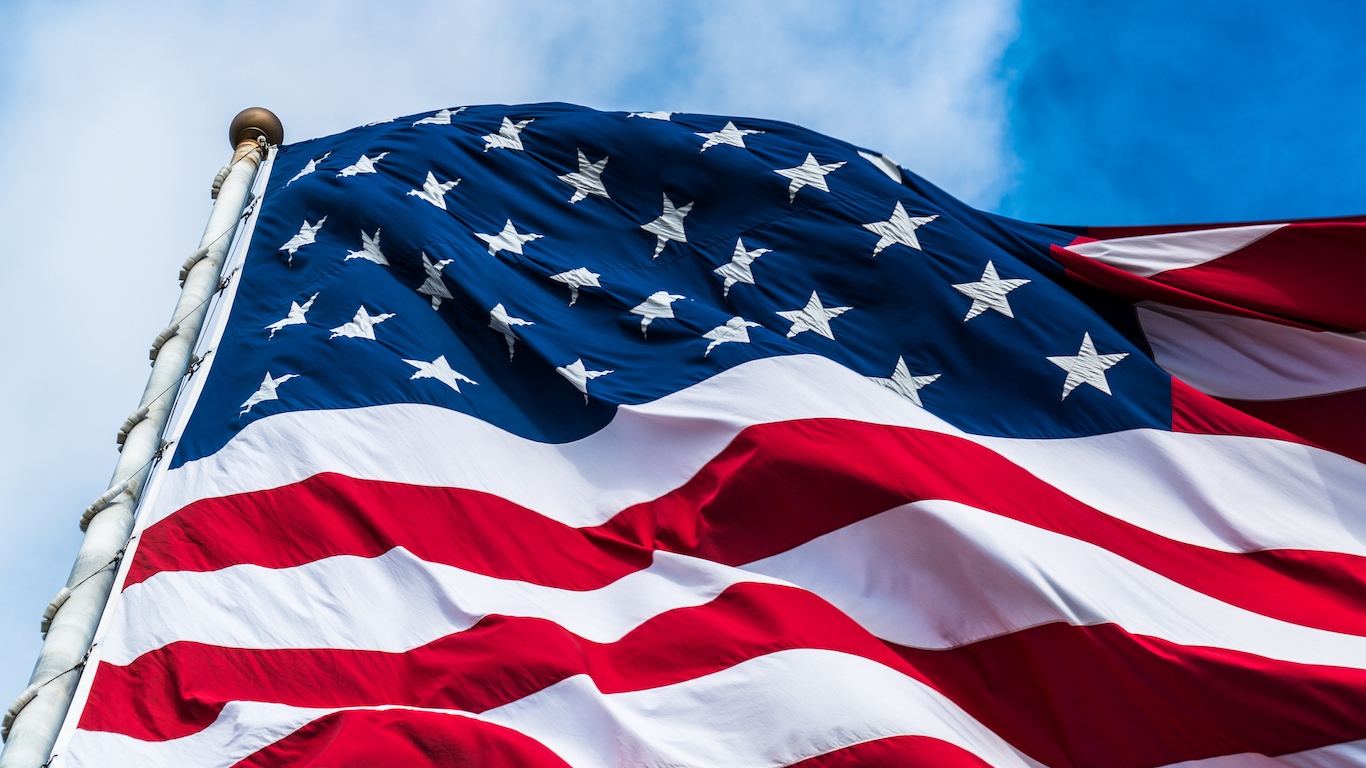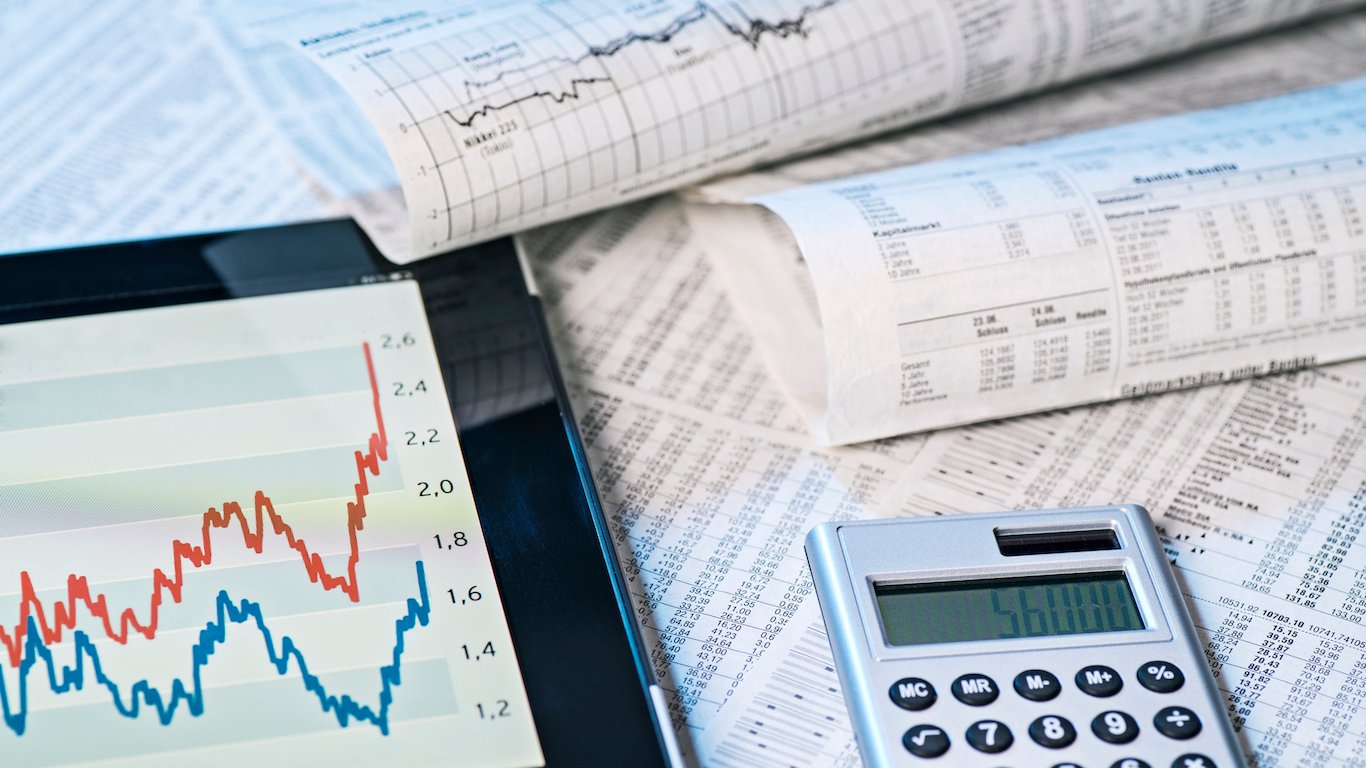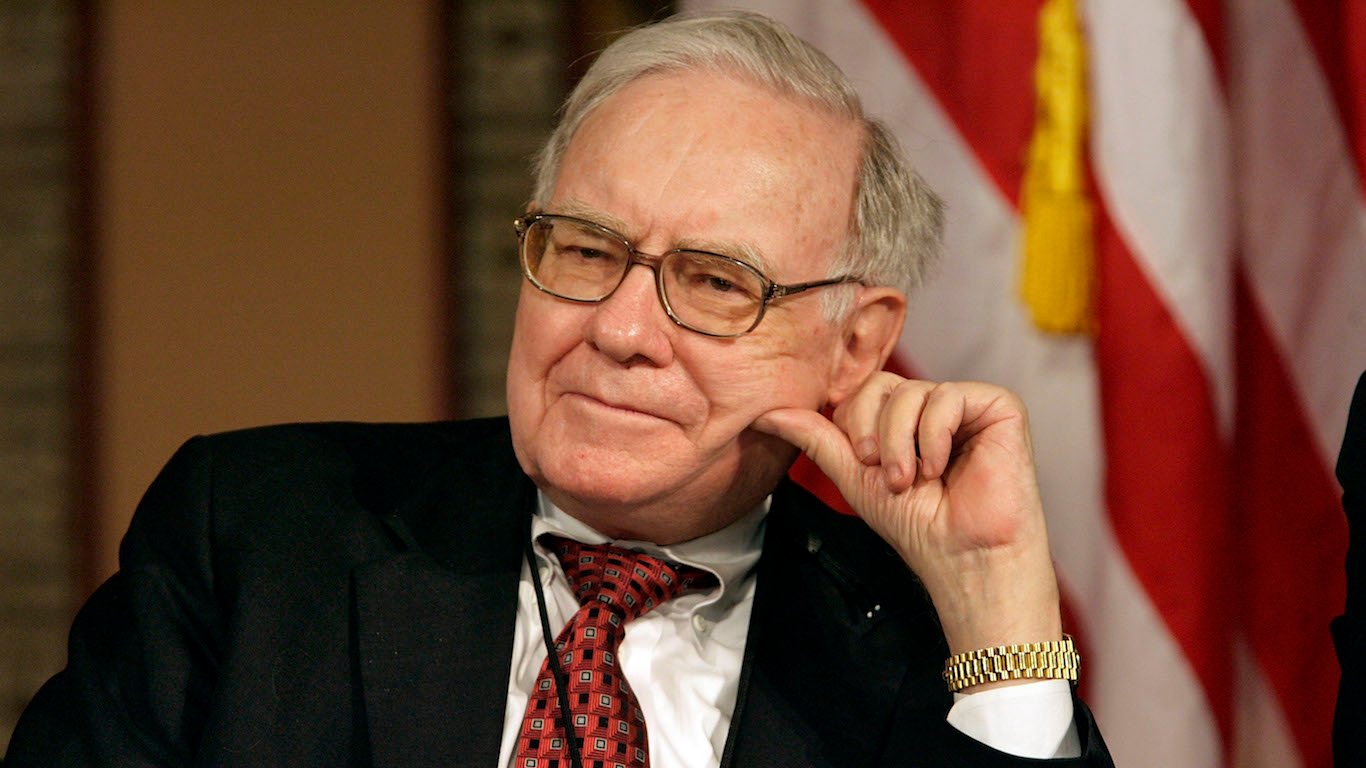

If Paul Revere were alive today, the financial media would have quoted him as saying, “A recession is coming! A recession is coming!” There is just one major problem. Not everyone agrees with the assessment that a recession is imminent. Moreover, if a recession does come, and the policies of today remain more or less status quo, then the next recession is not expected to be much more than what economists call a “garden variety recession” rather than a replay of the Great Recession of a decade ago.
24/7 Wall St. has been tracking the actual versus the perceived recession risks that the public keeps hearing about. This includes tracking actual economic data, corporate earnings and guidance, varying industry reports, economist and analyst reports, and even the daily financial market’s ups and downs. There are obvious risks that are already on the table that could lead to a recession — tax cuts have been fully factored in, the U.S./China trade war is no longer just a dispute, weakening job growth, weaker economic growth, slower corporate profits, an on-again-off-again inverted Treasury yield curve, over $15 trillion in negative bond yields between Europe and Japan, an inability for inflation to run where central bankers would want it to be, and there are even more issues.
All these negatives probably sound like they have to add up to another recession. That just isn’t automatically true in 2019, nor is it a foregone conclusion yet for 2020. History dictates that a recession will come. With the economic recovery being the longest of our lives and with the great bull market in stocks being 10 and a half years old, the constantly reported imminent recession actually may be overblown. It would be silly to say that a recession cannot be possible, but all the negative forces of today do not currently add up to a U.S. recession as a definite outcome in 2019 to 2020 (and not even definite in the immediate years after that).
It’s easy to be confused or even tricked by the daily media headlines. It’s also hard to ignore that some calls for recession are for political gain. This is not the first decade (and likely will not be the last) in which those calls have been heard. It’s also important to consider that “recessions” are not even equally defined from source to source. Traditional recession measurement taught by most economic classes is simply two consecutive quarters of negative gross domestic product (GDP), but the National Bureau of Economic Research uses a measurement of when the economy peaked to when it bottomed out and began improving.
Here we have compiled some public comments and reports, and we also have received multiple direct responses from various groups opining about the probability, timing and severity of the current recession odds. Again, one would be easy to be tricked into thinking the next recession is imminent by only read headlines using “recession” as an attention-grabber.
Given the trade war between the United States and China, we have compiled the actual numbers behind the office of the U.S. Trade Representative to show how much in actual goods actually are imported from China and how much are actually exported to China. The tariff numbers may sound atrocious on the surface, considering they run in the hundreds of billions of dollars, but the United States is now already more than a $21 trillion economy measured by GDP.
During the week of September 6, the Federal Reserve Bank of New York’s recession probability indicator showed that the odds of a recession appearing by August of 2020 were running at 38.0%. The prior reading was just 31.5% by July 2020.
Federal Reserve Chair Jerome Powell spoke on Friday, September 6. While he did not directly state whether the Federal Open Market Committee would cut interest rates in September, Powell did indicate that the Fed would do what was necessary to keep the expansion going and the markets interpreted that as a “yes.” That said, Powell’s words were very direct and clear on a broader issue: “We’re not forecasting or expecting a recession.”
Fed forecasting tools are not suggesting a recession, based on actual economic reports. The New York Fed’s Nowcast from September 6 was for 1.5% GDP growth in the third quarter of 2019 and 1.1% in the fourth quarter. The most recent data did lower those forecasts by 0.3 percentage point for the third quarter and 0.5 percentage point for the fourth quarter. The Federal Reserve Bank of Atlanta’s GDPNow model was updated on September 4 and suggested that third-quarter GDP would come in at 1.5% growth (down 0.2 percentage point from the prior reading).
On September 5, ADP’s payroll gains were stronger than what the Bureau of Labor Statistics reported. Some economists have pointed out that August is traditionally a weak print from the bureau and that it is likely to be revised higher. When ADP reported that a stronger than expected 195,000 private sector payrolls were added in August, Mark Zandi, chief economist of Moody’s Analytics, said in that ADP report: “Businesses are holding firm on their payrolls despite the slowing economy. Hiring has moderated, but layoffs remain low. As long as this continues recession will remain at bay.”
On September 5, CNBC host Jim Cramer noted that the trade talks hopes might get commentators to “ease up on the desire to endlessly call for a recession.” While that was noted, Cramer also said that all prior trade talks have failed and good data have been followed by weaker (economic) numbers.
On September 4, BNP Paribas issued its fourth-quarter global economic outlook. While not calling for a direct recession, the outlook for the globe and for the United States has come down. A sharp slowdown is seen in U.S. growth to just 0.9% growth for the fourth quarter of 2019, and that should act as a catalyst for monetary and fiscal easing beyond current expectations. BNP Paribas now sees just 3% global growth in 2020, with the U.S. ticking down to just 1.8% growth. That report gave notes on avoiding a recession while seeing interest rates continue their downward trajectory:
In our view, the global economy can still be pulled back from the brink of recession; there are no obvious signs of large global imbalances and the policy response is likely to be prompt. … We expect the 10y US yield to drop to 1.00% by the end of 2019, with a flattening bias on the 2s10s curve, before a recovery as the global outlook starts to improve. The increasing number of negative-yield bonds elsewhere in the world and the drop in FX hedging costs are likely to support demand for Treasuries even as yields decline.
Also on September 4, Peter Winter of Wedbush Securities opined about loan growth woes in the banking sector that are apparent for after the third quarter of 2019 and into 2020. He lowered his bank sector outlook for 2020. Winter’s report said:
Solid loan growth has been one of the few bright spots for the bank group this year. There is a general consensus among bank managements of a disconnect between positive borrower sentiment, strong loan pipelines and no signs of emerging credit deterioration, and how the media portrays the economy, especially the shape of the yield curve. The fear is the headline risk of a recession turns into a self-fulfilling prophecy. That said, we maintain our cautious view of the bank group given the unfavorable rate environment, which has gotten worse since July with the precipitous drop in the 10-year treasury. Plus, a number of leading economic indicators are down from recent peak levels and most are in a downtrend, making us even more cautious on our 2020 outlook.
In the first week of September, the Institute for Supply Management gave two different views. The manufacturing index fell under 50% to 49% (under 50% represents contraction) for the first time since January of 2016. The services index showed a more robust 56.4% reading that was above July and above expectations, and the United States is undoubtedly more of a services economy at this point. To prove the point, the most commonly used figure is that close to 70% of U.S. GDP is tied to consumer spending-related activities.
An August 30 review from Charles Schwab’s Liz Ann Sonders did address risks in the economy, but she pointed out where the yield curve inversion may not be the telltale sign of a recession:
The theme to our 2019 outlook was “be prepared” and we continue to see some clouds forming on the horizon. Aside from trade/tariff volleys (if only we could move aside from trade news), the latest concern has been the inversion of the 10-year/2-year Treasury yield curve. As you can see below—similar to the 10-year/3-month curve that first inverted in March—the 10-year/2-year inversion has preceded every recession since the 1960s. However, there were two periods—in 1966 and 1998—when the yield curve inverted, but a recession remained a fair distance away.
On August 29, Greg McBride, CFA, of BankRate.com, answered several questions directly about the chances of recession and the current outlook. The first question: Is the media using the term recession too frequently or misusing it like they use “decimated” now?
With the escalating trade dispute, inverted yield curve and Germany being on the cusp of recession, worries about a recession in the U.S. are understandable. But the strength of the American consumer and solid underlying labor market fundamentals mean recession is not an immediate concern in the U.S.
While no one can forecast the exact depth and timing of a recession, when are the current indicators really signaling a recession and how deep would McBride expect the recession to be compared to the Great Recession?
The truth is that recessions are really only evident in hindsight when the National Bureau of Economic Research pinpoints the beginning and end date of a recession. Nonetheless, rising unemployment, fewer hours worked and a slump in consumer spending such as retail sales are definite indicators of an economy that is contracting. Even a shallow recession isn’t fun because a few million people will lose jobs, those working will make less money or not see pay raises, returns on savings will disappear, and the stock market will fall 25% – 30%.
McBride also went a step further to show how the low Treasury yields also pose a further risk to investors at this time:
If the U.S. economy skirts a recession then the so-called ‘safe haven’ of Treasuries won’t be so safe as any rebound in bond yields will punish bond prices, hurting investors.
Canaccord Genuity equity strategist Tony Dwyer has said the countdown to a recession has begun. There is a caveat here though, in that Dwyer expects to see more upside first. On August 28, Dwyer’s report said:
After a long wait, the 2-10-year U.S. Treasury Yield Curve finally inverted, which means our countdown clock has started for a recession and “the” cycle peak in the S&P 500 (SPX). Over the past seven economic cycles, every recession was preceded by an inversion of the curve, but not before an extended lead time to recession and significant gains in the SPX to peak. In fact, looking at the last three cycles that have been similarly fueled by an excessive use of leverage, following the initial inversion of the curve the SPX rallies a median 34% in 22 months with a recession 24 months away.
On September 5, Dwyer’s note to Canaccord Genuity investors said:
We believe the increasingly pessimistic sentiment among individual investors, our key tactical indicators, and flight to quality as evidenced in U.S. Treasury yields set the stage for the next leg higher toward our 2020 SPX target of 3,350 driven by: (1) “less poor” global economic data; (2) significantly more accommodative monetary policy; and (3) news and tweet fatigue. Very few are betting on an improved growth outlook, but that is what the OECD CLI data suggest is already happening. There is no question the trade war is accelerating, but we believe it has largely kept investors on the sidelines over recent weeks, and as stated last Monday we believe it is time to react and expect the next leg higher toward our 2020 SPX target of 3350.
On August 29, Julia Pollak, a labor economist for the online employment marketplace ZipRecruiter, responded to several questions about employment around a recession and the growing risks. She did point out that the labor market is a lagging indicator, so even if there is trouble in the economy it may not show up in the labor market for some time. She said:
Unemployment is the lowest it has been in almost 50 years. Initial jobless claims are also at historic lows, and layoffs have been low and stable. The economy has produced an average of 165k jobs per month so far in 2019, which is lower than average job gains since the start of the expansion (199k) but higher than the average monthly number of new labor market entrants (100k). And the quit rate (the share of workers voluntarily quitting their jobs each month) is high and stable–a sign that workers feel confident that there are many good job opportunities and that it will be relatively easy to find another job.
Pollak also issued an update to Friday’s unemployment report:
Overall, today’s jobs report shows slowing private-sector job growth and slowing wage growth, which–while expected this late in the recovery–is somewhat disappointing after the rapid gains of the past two years. … Job growth is sufficient to maintain 3.7% unemployment, but the number of job gains is slightly inflated this month, due to government hiring of Census workers. The private sector only added 96k jobs, which marks a slowdown from the pace of job growth in 2017 and 2018.
On August 29, the investment bank Stifel Financial issued a report from institutional equity strategist Barry Bannister stating that the United States may see a recession as soon as May 2020, and if that holds true then stocks would begin selling off as early as December of this year. His anchor statement for investors: “Stocks may plunge in December 2019 with the standard lead time to the onset of recession.”
Ken Berman, the founder of Gorilla Trades, has some thoughts on the probability and expectations of the next recession. His responses were long, and a portion of the communication received said:
Fears of a global recession intensified in recent weeks, and the idea of a coming recession went mainstream, with the number of Google searches for the word ‘recession’ hitting a ten-year high. The reasons behind the change in sentiment include the escalation of the trade war between the U.S. and China, the economic slowdown in Europe and China, the market collapse in Argentina, and the increasing odds of a no-deal Brexit. The signals that the bond market has been sending lately, most notably the multi-year lows in Treasury yields and the inversion of the yield curve, just reinforced the fears. While the U.S. economy continues to expand and the global recession could still be avoided, let’s take a look at what a recession in 2020 could look like. … A lot of investors expect the next crisis to be similar to the Great Recession of 2008-2009, but they are most likely wrong. Should the recession really happen, it will be driven by vastly different factors, so it would affect your portfolio in different ways also.
A pronounced trend of flight-to-quality is apparent too, and would be likely to continue, should the economic conditions deteriorate further, with domestic equities and domestic-focused firms outperforming their international and international-focused peers. This is especially true for those companies most exposed to China and Europe, and since the issue of Intellectual Property (IP) and technology transfers is a crucial part of the debate with China, those tech firms with close connections to Chinese suppliers would remain under pressure.
Investors will likely favor large-cap stocks in comparison to smaller, more risky issues, and that’s why this week, the Russell 2000, the main small-cap index hit its lowest level since January. Declining Treasury yields also make large-cap stocks attractive, as the more valuable companies can harvest cheap financing easier, mostly through stock buybacks. On the other hand, the financial sector and especially large-cap banks would suffer, as the lower yields directly affect their profitability, while the dire state of the European and Chinese banking systems also poses risks even to the more stable domestic banks.
The traditionally defensive utilities, healthcare, and consumer staples sectors should also outperform in a recessionary environment since their income is less dependent on cyclical factors, and the declining yields make their stable, more ‘bond-like’ income streams more attractive. Although, government bond yields are at their all-time lows globally, the Federal Reserve still has some room to ease, and since Quantitative Easing (QE) is also an option, the ‘declining yield effect’ could be with us for a long time.
To sum it up, in case you are firmly in the ‘coming recession’ camp, you should favor large-caps, companies with stable income streams and low overseas exposure, with a focus on the domestic consumer economy, while avoiding export-focused firms, cyclical issues, tech firms with strong Chinese ties, and financials, especially large-cap banks.
This said, historically speaking, whenever the yield curve inverts – it tends to be a sign that a recession is coming; an inverted yield curve IS often a precursor to a recession. What some don’t understand is that the yield curve is just ONE of many factors that can define a recession – and the other factors are all doing just fine. There are several main economic indicators that seem to have predated a recession dating all the way back to 1973. In each of the recessions since then, many of the indicators either fell in “recessionary” or “neutral” – which isn’t the case for the current economy. Key signals such as labor and credit trends remain quite healthy!
On August 26, Realtor.com opined about the overuse of “recession” in the media. Its view was of course focused on housing, and George Ratiu, the firm’s senior economist, noted that people shouldn’t panic just yet and that they shouldn’t expect another real estate fire sale like the Great Recession. He said, “This is going to be a much shorter recession than the last one. I don’t think the next recession will be a repeat of 2008. … The housing market is in a better position.”
Redfin issued a more recent housing-and-recession report in the first week of September. Its chief economist, Daryl Fairweather, said:
Home prices are high right now, but they’re high because there’s not enough supply to meet demand, which means there’s not a bubble at risk of bursting. Most of today’s financed homeowners have excellent credit and a cushion of home equity, making them unlikely to default on their mortgage even if their weekly grocery bill grows or their stock portfolio shrinks in the next recession.
If the U.S. enters a recession in the next two years, it will likely be caused by the global trade war. U.S. industries that rely on exports, like the automotive industry and the agricultural industry, would be the most vulnerable and susceptible to layoffs. Homeowners who are laid off may not be able to continue covering their monthly mortgage payment and may be forced to sell their homes. And would-be homebuyers won’t feel so confident about making a big purchase when they don’t feel confident about their job security or their financial wellbeing. That could cause declines in home prices in markets whose economy depends on global trade, but home prices nationwide are likely to hold steady.
On August 23, Charles Schwab’s research department issued a note after stocks had plunged showing that the recession fears were higher. The escalating trade war and the weak global growth were shown to be pointing to a growing recession risk. Schwab Chief Investment Strategist Liz Ann Sonders, said:
If – or when – the next round of announced tariffs on Chinese goods is implemented, the estimated total direct hit to U.S. real gross domestic product would be nearly a half percentage point—and that doesn’t include the indirect hit to consumer, business and investor confidence, or the impact of China’s retaliatory tariffs.
Schwab’s research team also noted that additional tariffs are also likely to keep Treasury bond yields low and the yield curve inverted. Schwab stressed that a yield curve inversion has often, but not always, preceded a U.S. economic recession, with the caveat that the lead time can be long and variable. Kathy Jones, Chief Fixed Income Strategist for the Schwab Center for Financial Research, said:
The ongoing trade war can lead to even slower global growth, resulting in greater demand for U.S. Treasuries as investors seek out high-quality investments. With more than $16 trillion in negative-yielding debt across the globe, Treasury demand is likely to remain high, preventing yields from rising much. If the trade conflict continues to escalate, 10-year Treasury yields could test the all-time low of 1.32%.
A report from the National Association for Business Economics in mid-August showed that only 2% of economists were expecting a recession in 2019. The other 98% were split over whether that recession would arrive by the end of 2020 or by the end of 2021.
There are a few takeaways here that need to be addressed in determining whether the next recession is actually coming or is still just some far off, indeterminate date.
The way the National Bureau of Economic Research tracks recessions and recoveries, the actual gray line already could have happened, or it could be happening this quarter. That said, the traditional measurement of actual GDP contraction may not occur for multiple quarters into the future and technically may not be seen for many quarters.
Without getting into politics too much, the 2020 election cycle could create vast changes in the economy, and there are simply too many proposed ideas that haven’t been actually applied into real-world economic models to determine if the changes would throw the country into a recession — or if that would make a recession deeper than the “garden variety.”
Another measurement of recession is by what happens in your own neighborhood, city or state. Certain industries feel like they are in a recession already, while others are still thriving.
There’s also an age-old joke that a recession is when your neighbor loses their job and a depression is when you lose your job.
It seems to be a shoo-in that economic data will weaken or be less robust until some resolution in the trade war is reached or until enough time passes so that the business executives and consumers actually making spending decisions get to see how all these tariffs and industry targeting efforts pan out. Remember that slower economic growth and flat economic readings should not be enough to create a formal recession until those readings are in aggregate coming with minus signs in front of the numbers.
On top of GDP running at over $21 trillion, the continued reports of 3.7% unemployment and an incredibly resilient consumer with very high consumer confidence is likely to prevent any immediate negative GDP report that would trigger a broad recession.
In some ways, recessions can easily become self-fulfilling prophecies, if uncertainties last for too long. If companies remain cautious for too long, lower business spending, slower hiring (or layoffs, curtailment), lower marketing efforts and consumers deciding to save for a rainy day rather than buying more gifts combined it can lead to a recession.
Stay tuned.
Sponsored: Want to Retire Early? Here’s a Great First Step
Want retirement to come a few years earlier than you’d planned? Or are you ready to retire now, but want an extra set of eyes on your finances?
Now you can speak with up to 3 financial experts in your area for FREE. By simply clicking here you can begin to match with financial professionals who can help you build your plan to retire early. And the best part? The first conversation with them is free.
Click here to match with up to 3 financial pros who would be excited to help you make financial decisions.
Thank you for reading! Have some feedback for us?
Contact the 24/7 Wall St. editorial team.
 24/7 Wall St.
24/7 Wall St. 24/7 Wall St.
24/7 Wall St. 24/7 Wall St.
24/7 Wall St. 24/7 Wall St.
24/7 Wall St. 24/7 Wall St.
24/7 Wall St.


